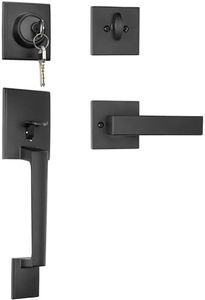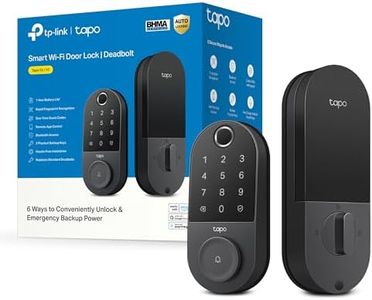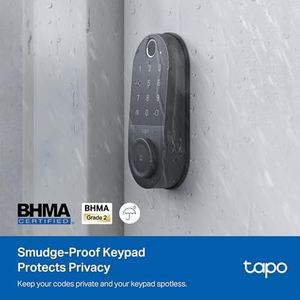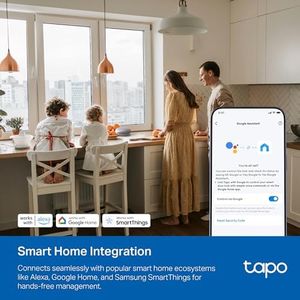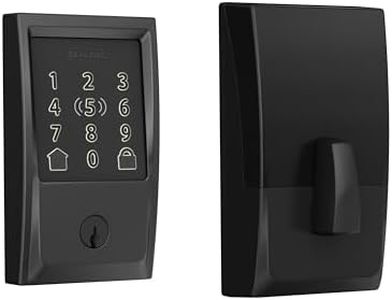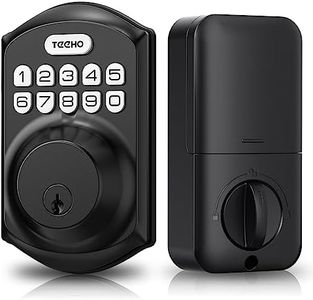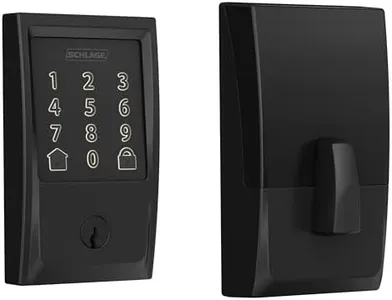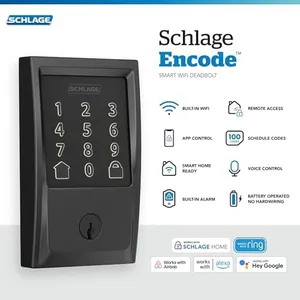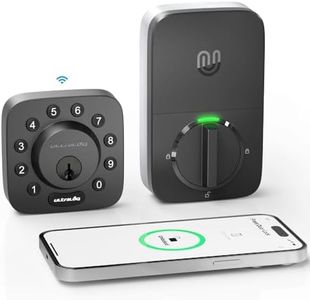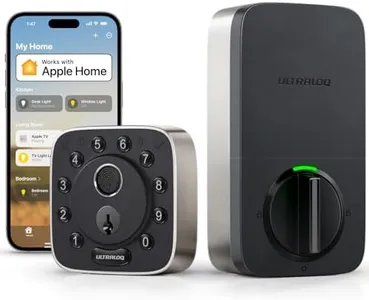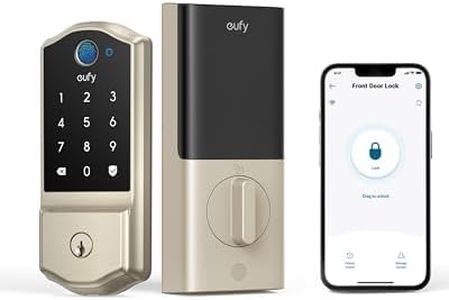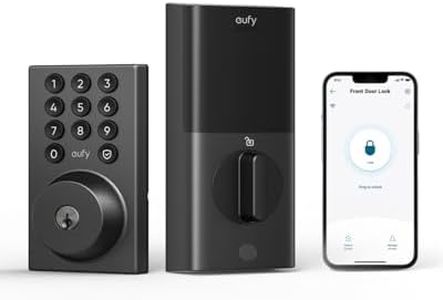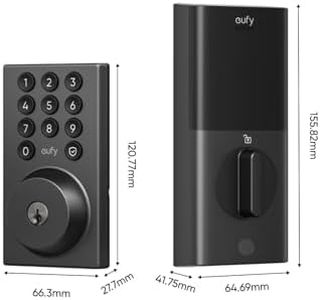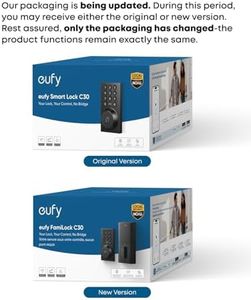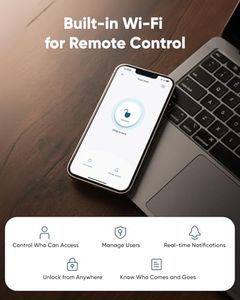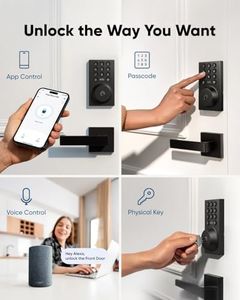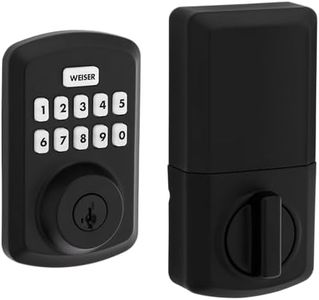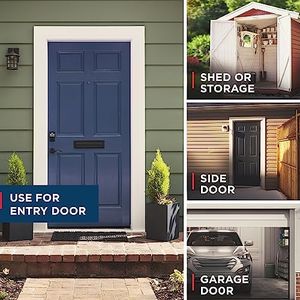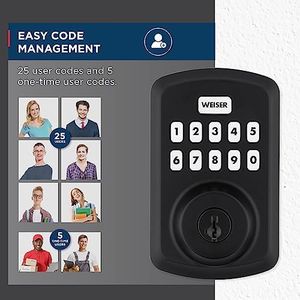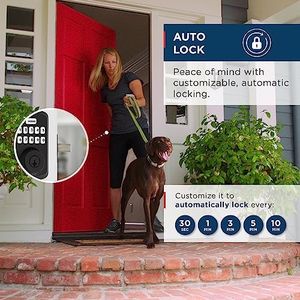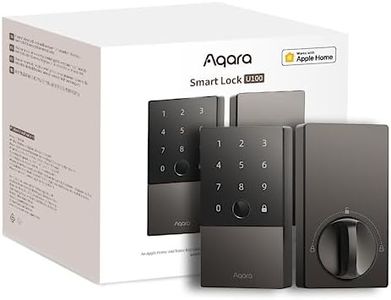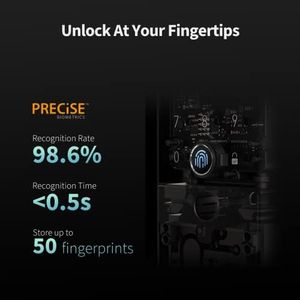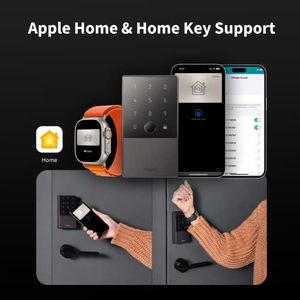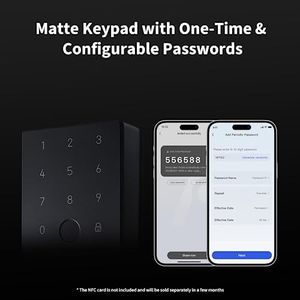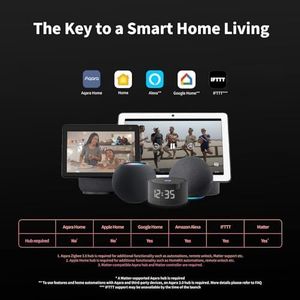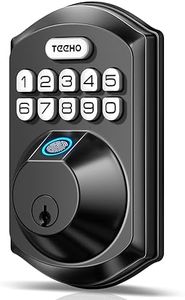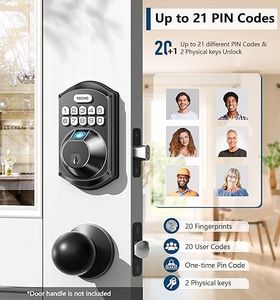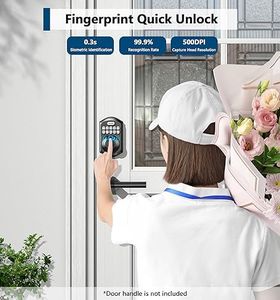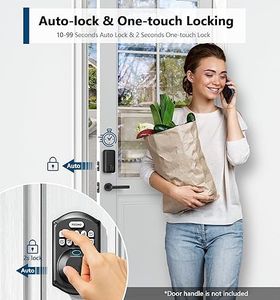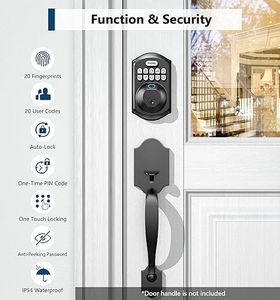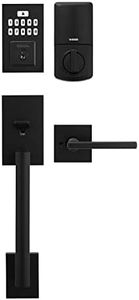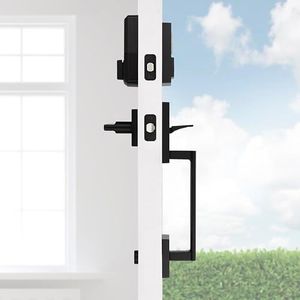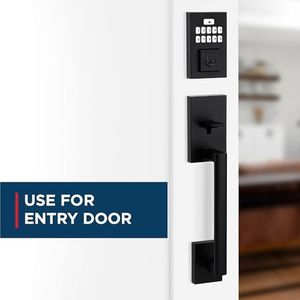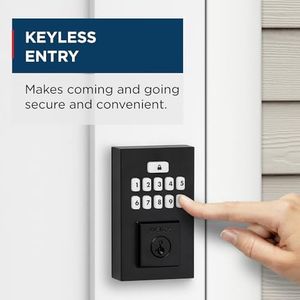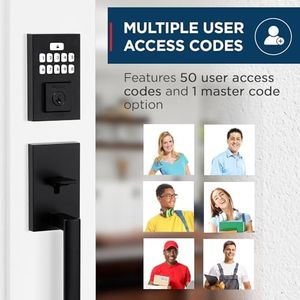We Use CookiesWe use cookies to enhance the security, performance,
functionality and for analytical and promotional activities. By continuing to browse this site you
are agreeing to our privacy policy
10 Best Smart Locks
From leading brands and best sellers available on the web.Top 10 Best Smart Locks 2025 in Canada
#1
Winner
TP-Link Tapo Smart Door Lock, Deadbolt | Keyless Entry, Fingerprint Recognition, Touchscreen Keypad & in-App Monitoring with Scheduled Access | 1-Year Rechargeable Battery | BHMA Grade 2 | Tapo DL110
TP-Link Tapo Smart Door Lock, Deadbolt | Keyless Entry, Fingerprint Recognition, Touchscreen Keypad & in-App Monitoring with Scheduled Access | 1-Year Rechargeable Battery | BHMA Grade 2 | Tapo DL110
Lock Type: Deadbolt
Access Methods: Fingerprint, keypad, Bluetooth, Wi-Fi, keys
Connectivity: Bluetooth, Wi-Fi
Power Source: Rechargeable battery, USB-C port
Security Features: Auto-lock, one-touch, passcode unlock
Smart Home Integration: Voice commands, compatibility check needed
Installation Requirements: Mounting template, hardware, stable Wi-Fi
Chosen by 1494 this week
Schlage Encode Plus WiFi Deadbolt Smart Lock with Apple Home Key, Keyless Entry Door Lock with Century Trim in Matte Black, BE499WB CEN 622
Schlage Encode Plus WiFi Deadbolt Smart Lock with Apple Home Key, Keyless Entry Door Lock with Century Trim in Matte Black, BE499WB CEN 622
Lock Type: Deadbolt
Access Methods: Keyless, 100 codes, Apple Home Keys
Connectivity: WiFi
Power Source: Battery-powered, batteries not included
Security Features: Access codes, alerts, remote lock
Smart Home Integration: Apple HomeKit, Alexa, Google Assistant
Installation Requirements: Screwdriver, no wiring needed
TEEHO TE001 Keyless Entry Door Lock with Keypad - Smart Deadbolt Lock for Front Door with 2 Keys - Auto Lock - Easy Installation - Matte Black
TEEHO TE001 Keyless Entry Door Lock with Keypad - Smart Deadbolt Lock for Front Door with 2 Keys - Auto Lock - Easy Installation - Matte Black
Lock Type: Keypad
Access Methods: Keyless entry, 20 user codes, passcode
Power Source: Batteries (not included)
Security Features: Anti-peeping, low battery, solid cylinder
Installation Requirements: Screw-in, fits standard US doors
eufy Security Smart Lock C220, Fingerprint Keyless Entry Door Lock, Built-in Wi-Fi, App Remote Control, Front Door Smart Lock Deadbolt, 8Months Battery, Reliable Power, IP53 Waterproof, BHMA Grade 3
eufy Security Smart Lock C220, Fingerprint Keyless Entry Door Lock, Built-in Wi-Fi, App Remote Control, Front Door Smart Lock Deadbolt, 8Months Battery, Reliable Power, IP53 Waterproof, BHMA Grade 3
Lock Type: Keypad
Access Methods: Fingerprint, app, keypad, key, Apple Watch
Connectivity: Built-in Wi-Fi
Power Source: 8 AA batteries
Security Features: BHMA Grade 3, alarms for attempts
Smart Home Integration: Alexa, Google Assistant, eufy app
Installation Requirements: Fits standard US/Canada deadbolts, 15 min
SCHLAGE Encode Smart WiFi Deadbolt with Century Trim in Matte Black (BE489WB CEN 622)
SCHLAGE Encode Smart WiFi Deadbolt with Century Trim in Matte Black (BE489WB CEN 622)
Lock Type: Keypad
Access Methods: Keypad, 100 unique codes max
Connectivity: Built-in WiFi 2.4GHz
Power Source: 4 AA batteries
Security Features: ANSI Grade 1, tamper alarm
Smart Home Integration: Works with Alexa, Schlage, Amazon Key
Installation Requirements: Fits 1-3/8” to 1-3/4” doors
Weiser Powerbolt 3 Matte Black Keyless Entry Door Lock/Deadbolt Lock, 10-Button Keypad Door Lock with Auto Lock and 12-Month Battery Life, Electronic Door Locks for Front Door, Home Décor
Weiser Powerbolt 3 Matte Black Keyless Entry Door Lock/Deadbolt Lock, 10-Button Keypad Door Lock with Auto Lock and 12-Month Battery Life, Electronic Door Locks for Front Door, Home Décor
Lock Type: Deadbolt, Keypad
Access Methods: Keyless, SmartKey re-keying, Keys
Connectivity: None
Power Source: Batteries (not included)
Security Features: Grade 3, Vacation Mode, Auto-Lock
Smart Home Integration: None
Installation Requirements: Screwdriver, no wiring, BILT app
Aqara Smart Lock U100, Fingerprint Keyless Entry Door Lock with Apple Home Key, Touchscreen Keypad, Bluetooth Electronic Deadbolt, IP65 Weatherproof, Supports Apple HomeKit, Alexa, Google, IFTTT, Gray
Aqara Smart Lock U100, Fingerprint Keyless Entry Door Lock with Apple Home Key, Touchscreen Keypad, Bluetooth Electronic Deadbolt, IP65 Weatherproof, Supports Apple HomeKit, Alexa, Google, IFTTT, Gray
Lock Type: Biometric
Access Methods: Fingerprint, Apple Key, Bluetooth, Keypad
Connectivity: Bluetooth, HomeKit, Alexa, Google, IFTTT
Power Source: 4 AA batteries, USB-C charging
Security Features: Fingerprint (50 users), Auto-lock, DND
Smart Home Integration: HomeKit, Alexa, Google, IFTTT
Installation Requirements: Wooden door, specific thickness, hole
#10
Weiser Matte Black Front Door Lock and Handle Set, SmartCode Keypad Door Lock with San Clemente Handleset & Halifax Interior Door Handle, Keyless Entry Door Lock, Front Door Handles with Deadbolt Lock
Weiser Matte Black Front Door Lock and Handle Set, SmartCode Keypad Door Lock with San Clemente Handleset & Halifax Interior Door Handle, Keyless Entry Door Lock, Front Door Handles with Deadbolt Lock
Lock Type: Deadbolt, Exterior Lock, Electronic, Handle Set
Access Methods: 10-button keypad, 50 user codes, SmartKey
Power Source: Batteries (not included)
Security Features: SmartKey Security, Mastercode, Motorized Lock
Installation Requirements: No hard wiring, app-guided instructions
Buying Guide for the Best Smart Locks
Choosing a smart lock is all about finding the right balance between convenience, security, and compatibility with your lifestyle. Smart locks can make entering your home easier, allow you to grant access to others remotely, and even keep track of who comes and goes. When picking a smart lock, it's important to think about how you'll use it, what features matter most to you, and how it will fit with your existing door and smart home setup. Understanding the key specifications will help you make a choice that keeps your home secure and your daily routine smooth.Lock TypeLock type refers to the way the smart lock attaches to your door and how it operates. There are retrofit locks that fit over your existing deadbolt, and full replacement locks that require you to remove your old lock entirely. Retrofit locks are easier to install and let you keep your original keys, while full replacements may offer more features and a fresh look. If you rent or want a simple setup, retrofit might be best. If you want a completely new system or extra security, consider a full replacement.
Access MethodsAccess methods are the ways you can unlock your door, such as with a smartphone app, keypad, fingerprint, key fob, or even a traditional key. Some locks offer multiple options, while others focus on just one or two. If you want flexibility for family and guests, look for locks with keypads or app-based access. If you prefer high-tech security, fingerprint access might appeal to you. Think about who will use the lock and how comfortable they are with technology to decide which access methods are best.
ConnectivityConnectivity describes how the smart lock communicates with your phone or other devices. Common options include Bluetooth, Wi-Fi, and sometimes Zigbee or Z-Wave for smart home integration. Bluetooth is simple and works locally, but Wi-Fi allows for remote control and monitoring from anywhere. If you want to control your lock when you're not home or integrate it with voice assistants, Wi-Fi or smart home compatibility is important. If you only need local control, Bluetooth may be enough.
Power SourceSmart locks are usually powered by batteries, and the type and life of these batteries can vary. Some use standard AA or AAA batteries, while others use rechargeable packs. Battery life can range from a few months to over a year, depending on usage and features. If you don't want to change batteries often, look for locks with longer battery life or low-battery alerts. Consider how easy it is to replace or recharge the batteries, especially if the lock is used frequently.
Security FeaturesSecurity features include things like encryption, auto-locking, tamper alarms, and the ability to track access history. Some locks also have built-in alarms or can alert you if someone tries to force the door. If security is your top concern, look for locks with strong encryption, two-factor authentication, and robust physical construction. If you want to monitor who enters your home, choose a lock that keeps detailed access logs.
Smart Home IntegrationSmart home integration means how well the lock works with other smart devices, like voice assistants (Alexa, Google Assistant, Siri), security systems, or automation platforms. Some locks can be controlled by voice or included in routines, like locking the door when you say 'goodnight.' If you already have a smart home setup or plan to build one, make sure the lock is compatible with your preferred system. If you don't use other smart devices, this may be less important.
Installation RequirementsInstallation requirements refer to how easy it is to put the smart lock on your door and whether it fits your door's thickness, type, and existing hardware. Some locks are designed for DIY installation and come with clear instructions, while others may need professional help. If you're not handy or have an unusual door, look for locks with simple installation or check compatibility guides. If you enjoy DIY projects, you might be comfortable with more complex setups.
